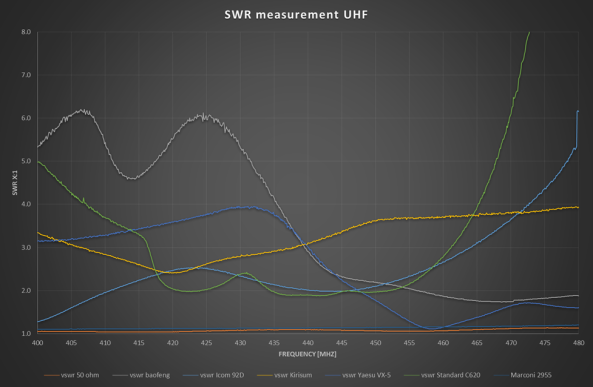 Antenna testing is hard (II)
Antenna testing is hard (II)
This article follows up on this one. The title could also be: doing measurements on hand held radios is hard. Actually, some measurements I did in the past might not be so accurate after all.
Measuring in dBm
If you measure in dBm, what I always did, you assume that the device at the other end is 50 Ohms, just like the manufacturer promises you in the specs. Slowly but surely we are finding out that this is not always the case. As a result I might have to switch to microvolt (µV), a method which doesn’t require a perfect 50 Ohms at the other end.
Can’t we just convert it? 0.5 µV @ 50 ohms = -113 dBm, a piece of cake, right? No. You must know the actual impedance of the receiver if you want to convert from dBm to µV. Erik PE1RQF did some measurements on a few hand held radios to find out the true impedance. The outcome was, well, a bit scary.

If a device is 50 Ohms, the SWR should be 1:1. Only a perfect dummy load and the Marconi RF generator are.
What this means for us
What this outcome basically means is that generating cold numbers on sensitivity and antenna performance are nice, but don’t tell the whole story, or could be misleading.
- Antennas which prove to be the best performers (RX/TX, VSWR), tested under optimal conditions, are not necessarily the best performers on a specific brand/model of hand held radio.
- There are antennas which aren’t 50 Ohms at all, but could very well outperform everything else on the market because your radio isn’t 50 Ohms either.
Do the test yourself
The best example I can give you is this one: take a Baofeng BF-666S, 777S or 888S, use the stock antenna, and make notes of the performance in the field. Try to hit repeaters which are barely in range. If you have a field strength meter, measure field strength when transmitting.
Remove the stock antenna and replace it by a Nagoya NA-701, NA-771, the $3.79 antenna, or the Baofeng UV-B5 antenna. I tried all of these; just pick whatever 3rd party antenna you have. Repeat the tests.
What happened here is that the short stock antenna was the best of the bunch, all 3rd party antennas had a negative influence on the performance of this specific Baofeng model. The same 3rd party antennas mentioned above did improve the performance of the Baofeng UV-5R, often by a wide margin.
Exception to the rules
The funny thing is that reception suffered greatly too. This is quite uncommon and a sign that hand held radios don’t follow the rules. For example, if you just want to receive on 20 meters and your dipole is 2×6 meters instead of 2×5 meters, you would never notice the difference. With your hand held radio however you will.













Hans,
Can you elaborate on the test setup that Erik used to measure the source impedance of the radios? The chart shows SWR which is a bit limiting for interpreting the results.